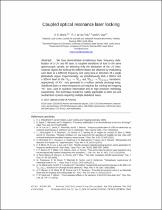JavaScript is disabled for your browser. Some features of this site may not work without it.
- ResearchSpace
- →
- Research Publications/Outputs
- →
- Journal Articles
- →
- View Item
| dc.contributor.author |
Burd, CC

|
|
| dc.contributor.author |
Du Toit, PJW

|
|
| dc.contributor.author |
Uys, H

|
|
| dc.date.accessioned | 2014-11-11T11:00:02Z | |
| dc.date.available | 2014-11-11T11:00:02Z | |
| dc.date.issued | 2014-10 | |
| dc.identifier.citation | Burd, S.C, Du Toit, P.J.W and Uys, H. 2014. Coupled optical resonance laser locking. Optics Express, vol. 22(21), pp 25043-25052 | en_US |
| dc.identifier.issn | 1094-4087 | |
| dc.identifier.uri | http://www.opticsinfobase.org/view_article.cfm?gotourl=http%3A%2F%2Fwww%2Eopticsinfobase%2Eorg%2FDirectPDFAccess%2F5FC459AC-DD5D-6F91-42A998CB84139032_301979%2Foe-22-21-25043%2Epdf%3Fda%3D1%26id%3D301979%26seq%3D0%26mobile%3Dno&org= | |
| dc.identifier.uri | http://hdl.handle.net/10204/7768 | |
| dc.description | Copyright: 2014 Optical Society of America. This is an OA journal. The journal authorizes the publication of the information herewith contained. Published in Optics Express, vol. 22(21),pp 25043-25052 | en_US |
| dc.description.abstract | We have demonstrated simultaneous laser frequency stabilization of a UV and IR laser, to coupled transitions of ions in the same spectroscopic sample, by detecting only the absorption of the UV laser. Separate signals for locking the different lasers are obtained by modulating each laser at a different frequency and using lock-in detection of a single photodiode signal. Experimentally, we simultaneously lock a 369nm and a 935nm laser to the (sup2)S(sub1/2) (sup2)P(sub1/2) and (sup2)D(sub3/2) (sup3)D(sub[3/2]1/2) transitions, respectively, of Yb(sup+) ions generated in a hollow cathode discharge lamp. Stabilized lasers at these frequencies are required for cooling and trapping Yb(sup+) ions, used in quantum information and in high precision metrology experiments. This technique should be readily applicable to other ion and neutral atom systems requiring multiple stabilized lasers. | en_US |
| dc.language.iso | en | en_US |
| dc.publisher | Optical Society of America | en_US |
| dc.relation.ispartofseries | Workflow;13656 | |
| dc.subject | UV lasers | en_US |
| dc.subject | Optical resonance laser locking | en_US |
| dc.subject | Neutral atom systems | en_US |
| dc.subject | Optics | en_US |
| dc.title | Coupled optical resonance laser locking | en_US |
| dc.type | Article | en_US |
| dc.identifier.apacitation | Burd, C., Du Toit, P., & Uys, H. (2014). Coupled optical resonance laser locking. http://hdl.handle.net/10204/7768 | en_ZA |
| dc.identifier.chicagocitation | Burd, CC, PJW Du Toit, and H Uys "Coupled optical resonance laser locking." (2014) http://hdl.handle.net/10204/7768 | en_ZA |
| dc.identifier.vancouvercitation | Burd C, Du Toit P, Uys H. Coupled optical resonance laser locking. 2014; http://hdl.handle.net/10204/7768. | en_ZA |
| dc.identifier.ris | TY - Article AU - Burd, CC AU - Du Toit, PJW AU - Uys, H AB - We have demonstrated simultaneous laser frequency stabilization of a UV and IR laser, to coupled transitions of ions in the same spectroscopic sample, by detecting only the absorption of the UV laser. Separate signals for locking the different lasers are obtained by modulating each laser at a different frequency and using lock-in detection of a single photodiode signal. Experimentally, we simultaneously lock a 369nm and a 935nm laser to the (sup2)S(sub1/2) (sup2)P(sub1/2) and (sup2)D(sub3/2) (sup3)D(sub[3/2]1/2) transitions, respectively, of Yb(sup+) ions generated in a hollow cathode discharge lamp. Stabilized lasers at these frequencies are required for cooling and trapping Yb(sup+) ions, used in quantum information and in high precision metrology experiments. This technique should be readily applicable to other ion and neutral atom systems requiring multiple stabilized lasers. DA - 2014-10 DB - ResearchSpace DP - CSIR KW - UV lasers KW - Optical resonance laser locking KW - Neutral atom systems KW - Optics LK - https://researchspace.csir.co.za PY - 2014 SM - 1094-4087 T1 - Coupled optical resonance laser locking TI - Coupled optical resonance laser locking UR - http://hdl.handle.net/10204/7768 ER - | en_ZA |






